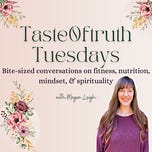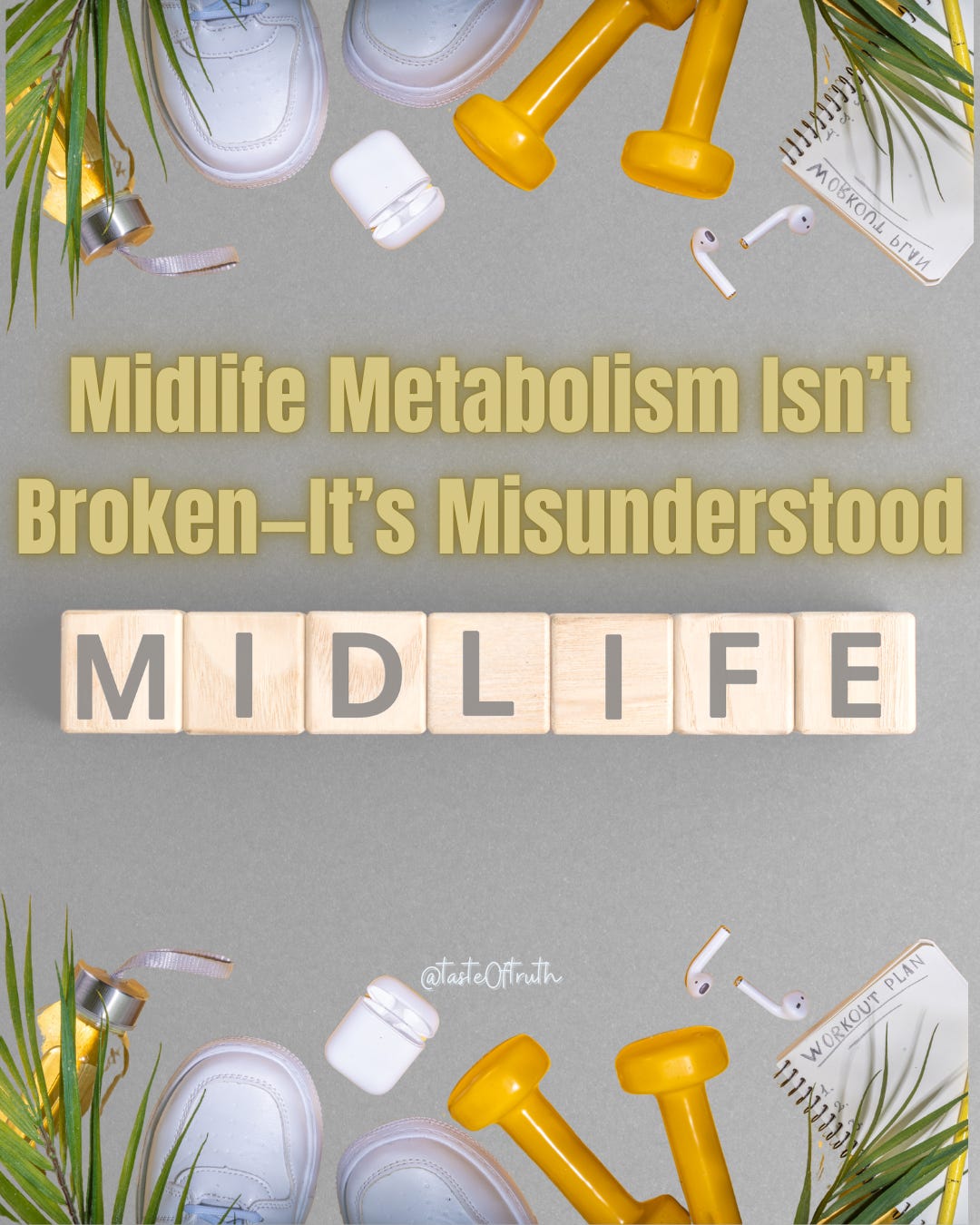Welcome back to Taste of Truth Tuesdays!
Okay, I know, I said I was wrapping up the podcast at the end of last season. And technically, that’s still true.
But I also told you that when a conversation really lights me up when I come across someone or something I know you need to hear that I would be dropping in with some bonus episodes.
Today is one of those days.
If you’re a woman in midlife witnessing changes in your body, let’s be honest-hearing one more expert say “just move more and eat less” might make you scream. That tired, oversimplified advice ignores the very real ways our bodies change—and the decades of life we’ve already lived in them.
Midlife, generally defined as the ages between 37 and 65, isn’t just a calendar phase. It’s a biological, emotional, and identity-shifting chapter. For women, it often marks the beginning of perimenopause—the transitional period leading up to menopause, when the ovaries gradually produce less estrogen. Menopause itself is defined as the 12-month mark after your final menstrual period, but the hormonal fluctuations and symptoms often begin years before and can last well beyond that point.
To really understand what’s happening in our bodies now, we have to rewind the clock.
From puberty, our bodies have been shaped by an elegant hormonal dance. Estrogen, progesterone, and to a lesser extent testosterone, govern everything from our cycle to our skin, from our energy to our emotional responses. These hormones rise and fall in predictable patterns until they don’t. And when they don’t, you feel it.
Hot flashes. Sleep disruptions. Brain fog. Mood swings. Slower recovery from workouts. A scale that doesn’t seem to budge no matter what you do. And the silent undercurrents like the gradual loss of bone density—osteopenia—that often go unnoticed until it’s too late.
These aren’t random annoyances. They’re signals. And they deserve to be understood.
In this post and in today’s podcast episode, I talk with registered dietitian and research wizard
about what actually helps us thrive during perimenopause and menopause. We get into why muscle is metabolic gold, why cardio isn’t always the answer (but is important!), and how biofeedback your body’s own cues like hunger, energy, sleep, stress and mood can tell you more about what’s working than any calorie tracker or influencer’s reel ever could.We also challenge the idea that your bathroom scale is the best measure of health. Spoiler alert: it’s not. Tools like DEXA scans provide deeper insight into your bone density and lean mass—two things that matter more than “weight” ever could in this stage of life. And while your smart scale using bioelectrical impedance might not be as accurate, it can still help you track general trends if you know how to interpret it.
One part of our conversation that hit me hard was Maryann’s mention of the body fat research around fertility. Scientists have found that a minimum of 17% body fat is required just to get a menstrual cycle, and about 22% is needed to maintain ovulation. But here's the real shocker: in mature women, regular ovulatory cycles are often supported best at 26–28% body fat. (PMID: 3117838, 2282736) That means what many of us have been taught to chase ultra-lean physiques (around 17 BF% or so), chronic calorie restriction, or overtraining can actually backfire on our reproductive health, bone health, and overall vitality.
In populations where food is scarce or physical demands are high, we see patterns: delayed first periods, longer gaps between births, earlier menopause. It’s the body adapting for survival. But in modern life, we sometimes impose these same conditions on ourselves in the name of “fitness.”
Many women are unknowingly under-eating due to a fear of eating too much, past experiences with chronic dieting, or a lack of understanding of their energy needs. A recent review of 42 studies published between 2013 and 2020 found that women are more likely to be deficient in essential nutrients, with between 30% and 70% of women in the studies being energy deficient.
And here’s why that matters: your body won’t prioritize reproduction when it’s under-fueled. Ovulation is one of the first things to go when energy is scarce—and without ovulation, you don’t produce progesterone. So that chronic under-eating? It’s not just draining your energy; it’s likely tanking your progesterone too.
And while estrogen usually gets the spotlight in menopause care often treated as the main character it’s progesterone that deserves a standing ovation. Many women are told they “need progesterone” just to protect themselves from estrogen’s effects, as if it’s merely a buffer. But that undersells its brilliance.
The name progesterone literally means “pro-gestation,” but its impact goes far beyond fertility. Progesterone is a master regulator. It stabilizes tissues, supports metabolic balance, calms inflammation, protects against stress, and even plays a role in brain health. While estrogen stimulates, progesterone shields. While estrogen builds, progesterone restores.
What I find so fascinating, is our bodies produce far more progesterone than estrogen especially after ovulation and during pregnancy. That’s not a fluke. It reflects just how critical progesterone is to our overall well-being.
So, when ovulation slows or disappears in midlife, it’s not just your period going quiet. It’s this entire downstream network of hormonal resilience especially progesterone that starts to fade. And that’s when my friends when symptoms ramp up.
Understanding this isn’t just about managing menopause. It’s about honoring your biology, updating your strategy, and supporting your body like the powerful, responsive system it actually is.
If we want to optimize our hormones in midlife, we have to re-evaluate our goals. This isn’t about grinding harder it’s about getting smarter. And to get smarter, we need to zoom out.
Ovulation isn’t just some fertility footnote-it’s the main event of your cycle. But many of us were taught that the bleed is the cycle. Nope. That’s just the after-party. The headliner? Ovulation.
Why does this matter in midlife?
Because ovulation is the only way your body makes meaningful amounts of progesterone and as Maryann points out in today’s interview, she wishes she’d known just how crucial that was earlier in life.
Here is the main take away: your body only ovulates consistently when it feels safe and well-nourished. That means you’re eating enough, not overtraining, and not stuck in a cortisol-fueled chaos spiral. Ovulation isn’t just about fertility—it’s a vital sign of overall health.
And the two hormones that anchor your cycle—estrogen and progesterone—do far more than regulate your period. They influence nearly every system in your body: from bone density to brain function, insulin sensitivity to mitochondrial health.
And what’s so important to know: progesterone is the first hormone to quietly disappear as you enter perimenopause. That’s why your energy feels off, your sleep gets wonky, and your tolerance for stress tanks. Your body isn’t broken. It’s adapting.
So, let’s break the rules, rewrite the midlife playbook, and finally start listening to the wisdom our bodies have been whispering all along.
That’s all I’ve got for you today, folks—but don’t go too far. I’ve got some incredible bonus episodes in the works that you won’t want to miss.
First up: I’ll be sitting down with a neuroscience researcher,
whose Substack article, “PTSD & Complex PTSD Are NOT the Same Thing,” is hands-down one of the clearest, most validating breakdowns I’ve ever read on how CPTSD rewires your brain and what it actually takes to heal. So, if you’ve ever felt stuck, misunderstood, or like your brain just won’t “come back online” … stay tuned. We’re not just talking trauma. We’re talking nervous system intelligence, identity repair, and body-based healing that gets to the root.And later, I’ll be joined by
a bold, unapologetic voice in the fight against collectivist ideologies. An organizational psychologist turned independent journalist, Karlyn has spent thousands of hours inside radical leftist groups and now runs Decode the Left, the only anti-communist platform of its kind. We’ll dive into her investigative work, her infamous “Spy Streams,” and why understanding the difference between Democrats and actual socialists matters more now than ever.So—if nuance, nerve, and a whole lot of curiosity are your thing? Hit that follow button. More truth-telling conversations are just around the corner.
Until next time: maintain your curiosity, embrace skepticism, and keep tuning in. 🎙️🔒
I recently sat down with Balance Banter to share a very personal part of my story — my unexpected entry into religion during the pandemic, what pulled me in, what made me question, and how I began to deconstruct without losing my curiosity. We talk faith, control, community, and what it really means to rebuild your worldview from the ground up. If you’ve ever felt like you’re standing at the crossroads of belief and disillusionment, this one’s for you.
LINKS:
In-depth-guide-on-midlife-weight
The Hidden Risks of Ozempic: Rapid Weight Loss Can Weaken Bones and Muscles
Farmer Vs Banker episode Move More, Eat Less? The Lie That Won’t Die
Resistance-exercise-perimenopause-symptoms
To take hormone therapy or not to take hormone therapy
Contrary to popular belief, a larger body may actually be healthier (insta post)
Why Are Americans So Obsessed With Protein? Blame MAGA.


















Share this post